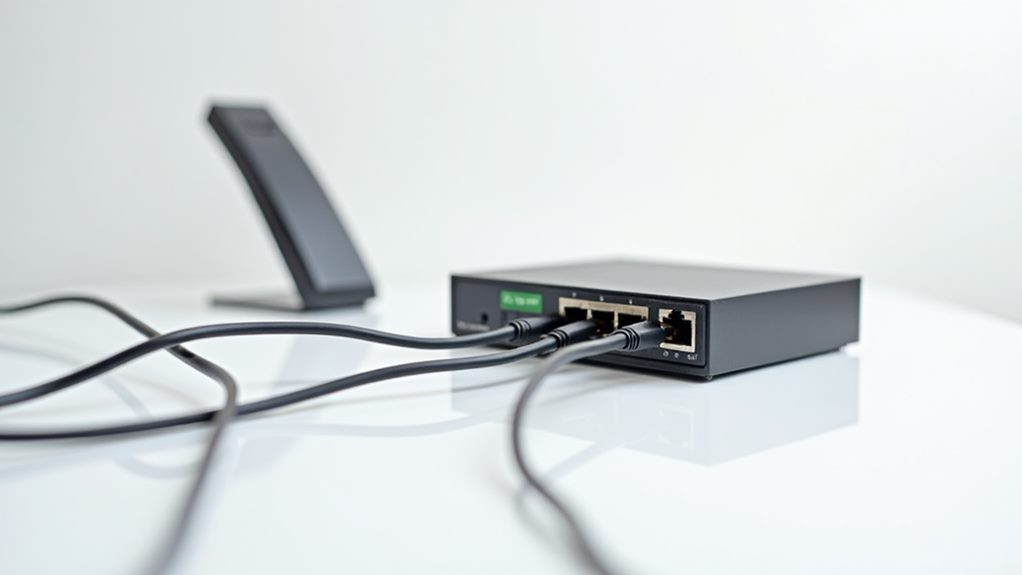While VoIP can technically operate without a router through direct IP connections, you'll typically need one for peak performance and functionality. Your router serves as the central command center for VoIP operations, managing bandwidth allocation, prioritizing voice packets through QoS settings, and ensuring secure communications. For reliable VoIP service, you'll want a router that can deliver 100 kbps to 1 Mbps per active call and maintains latency under 150ms. Modern routers with dual-band capabilities and VoIP-specific features offer enhanced call quality and security. Understanding your router's role in VoIP implementation will help you maximize your system's potential.
Understanding VoIP Technology

VoIP technology fundamentally transforms traditional voice communication by converting analog voice signals into digital data packets for transmission over IP networks. When you're using VoIP services, your voice travels through the internet rather than conventional phone lines, creating a more versatile and feature-rich communication system.
VoIP uses packet switching technology for efficient data transmission, enabling multiple calls to occur simultaneously over a single connection. To fully grasp how VoIP works, you'll need to understand that it's built on a foundation of protocols that enable seamless voice transmission across the internet. Your voice gets digitized and compressed into data packets, which are then reassembled at the destination. This process requires a stable internet connection to maintain call quality and prevent issues like jitter or latency.
You'll find that VoIP services offer advanced features you won't typically get with traditional phone systems. These include integrated voicemail, call forwarding, and teleconferencing capabilities.
When you're setting up VoIP, your router plays a vital role in managing these data packets and ensuring smooth communication flow. The system can also work alongside your existing landline infrastructure, giving you the flexibility to maintain both traditional and internet-based communication channels while benefiting from VoIP's enhanced capabilities.
Router Role in VoIP Systems
Your VoIP system's functionality depends critically on a router's core networking capabilities, which establish and maintain the essential pathways for voice data transmission over IP networks.
A router equipped with advanced features, such as Quality of Service (QoS), enhances the prioritization of voice traffic, ensuring improved call clarity.
Through precise network traffic management, your router orchestrates the flow of voice packets while balancing other data requirements across your network infrastructure.
The router's ability to implement Quality of Service (QoS) protocols directly impacts your VoIP performance by prioritizing voice traffic and maintaining call clarity under varying network conditions.
Core Router Networking Functions
Modern networking relies heavily on routers to set up and maintain effective VoIP communications. Your router serves as the central command center, orchestrating the flow of voice data packets between your devices and the broader internet infrastructure.
When you're running VoIP service through your network, the router's intelligent routing protocols guarantee your calls reach their intended destinations efficiently. Proper configuration of your router's firewall is vital for allowing specific VoIP ports to optimize call quality and prevent disruptions from mismanaged traffic understanding firewall interaction.
Your router's QoS settings play an essential role in maintaining consistent call quality. These settings automatically detect and prioritize VoIP traffic over less time-sensitive data, preventing issues like voice delays or choppy audio.
You'll need to verify your router can handle the necessary bandwidth requirements – typically 100 kbps to 1 Mbps per active call.
Beyond basic connectivity, your router provides important security features that protect your VoIP communications. The built-in firewall capabilities shield your voice data from potential cyber threats, while advanced routing protocols maintain stable connections for your video conferencing and messaging services.
You'll find that modern routers can simultaneously manage multiple VoIP-related tasks, from handling concurrent calls to supporting various communication protocols, making them indispensable for reliable VoIP performance.
Network Traffic Management Benefits
Network traffic management stands as a cornerstone benefit of router implementation in VoIP systems. When you're operating VoIP phones within your network infrastructure, you'll find that modern routers actively prioritize voice data packets through Quality of Service settings, ensuring your calls remain crystal clear and latency-free.
You'll experience significant advantages through your router's traffic management capabilities. By intelligently allocating bandwidth, your router prevents network congestion that could otherwise cause disrupting audio dropouts during critical calls.
You're also gaining access to dual-band functionality, where your VoIP traffic can utilize the less congested 5GHz band, separating it from routine data traffic on the 2.4GHz spectrum.
Your router's advanced features don't stop at basic traffic management. You're getting thorough security through built-in firewalls and NAT traversal support, protecting your VoIP communications from external threats.
This robust traffic management system enables you to expand beyond basic calling – you'll be able to conduct video conferences and handle multiple simultaneous calls without compromising call quality.
Through these sophisticated traffic management protocols, your router transforms from a simple network device into an essential component of your VoIP infrastructure.
Network Requirements for VoIP

You'll need a minimum bandwidth of 100 kbps to 1 Mbps per call to maintain clear VoIP communications, with proper QoS settings on your router to prioritize voice packets over standard data traffic.
Your network security configuration must include encrypted connections, firewall protocols, and VLAN segregation to protect your VoIP infrastructure from potential threats and unauthorized access.
Implementing dual-band router capabilities (2.4 GHz and 5 GHz) will optimize your VoIP performance by reducing interference and managing bandwidth allocation more effectively.
Minimum Bandwidth Speed Requirements
While VoIP technology offers flexible communication solutions, it requires specific bandwidth thresholds to function effectively. For your VoIP system to deliver reliable service, you'll need a minimum bandwidth of 100 kbps to 1 Mbps per call. This baseline requirement guarantees you're equipped to handle basic voice communications through your router and VoIP setup.
When you're planning your network infrastructure, consider that ideal quality of service demands more than just meeting minimum bandwidth requirements. You'll want to factor in concurrent calls using your system – each additional simultaneous call requires its own bandwidth allocation. For a business environment where multiple team members make calls regularly, you'll need to scale your bandwidth accordingly.
Your connection must also maintain latency below 150 milliseconds and jitter under 30 ms to guarantee clear communication. These metrics are vital for maintaining call quality and preventing disruptions.
If your network experiences frequent fluctuations, you might need to upgrade your service plan or implement Quality of Service (QoS) settings on your router. Remember, stable internet connectivity is essential for VoIP to function reliably, so prioritize consistency in your network performance.
Router QoS Settings Impact
Router Quality of Service (QoS) settings stand out as a critical component in establishing reliable VoIP communications across your network infrastructure. When you setup a VoIP system, your router's QoS capabilities guarantee that voice traffic receives priority treatment, maintaining call clarity even when your network handles multiple data streams simultaneously.
This prioritization directly impacts your call quality by reducing latency and jitter, common issues that can disrupt business communications.
To achieve the best VoIP performance, your router's QoS settings dynamically allocate bandwidth based on real-time network conditions. You'll find that modern routers come equipped with VoIP-specific QoS presets, making it easier to optimize your network without diving deep into technical configurations.
When properly configured, router QoS settings notably reduce dropped calls and audio lag, guaranteeing your voice communications remain crystal clear.
You'll want to enable QoS features on your router to manage multiple data streams effectively. This becomes particularly important when other devices on your network are consuming bandwidth simultaneously.
With proper QoS implementation, your VoIP calls maintain their quality regardless of concurrent network activities, providing you with reliable, professional-grade voice communications.
Network Security Essentials
Network security forms the backbone of any robust VoIP implementation, requiring specific protocols and configurations to protect voice communications from potential threats. Your router's built-in security features play an essential role in safeguarding your VoIP system from unauthorized access and potential cyber attacks.
To guarantee your VoIP communications remain secure, you'll need to configure your router's firewall settings properly. This includes setting up specific rules for SIP ports while maintaining strict security protocols for all other traffic.
You're not just protecting voice calls; you're securing sensitive data that flows through your network during VoIP sessions.
When you implement security measures, make sure they don't conflict with your QoS settings. Your router needs to balance security protocols with performance requirements, maintaining that vital 100 kbps to 1 Mbps bandwidth per call while keeping unauthorized users out.
You'll want to regularly update your router's firmware to patch security vulnerabilities and guarantee top-level protection.
Router Features That Support VoIP
Modern VoIP deployments rely heavily on specific router features that enhance voice communication performance. When you're using VoIP, your router's Quality of Service (QoS) capabilities become essential, as they actively prioritize voice traffic over other data types, ensuring your calls remain crystal clear even during peak network usage.
You'll find that dual-band routers supporting both 2.4GHz and 5GHz frequencies offer you distinct advantages for VoIP implementation. The 5GHz band provides a less crowded pathway for your voice communications, while the router's advanced bandwidth management supports multiple simultaneous calls without compromising quality.
If you're setting up a VoIP system, look for routers with DECT integration, as they'll allow you to connect VoIP handsets directly to your network infrastructure.
To maintain peak VoIP performance, you'll need to keep your router's firmware current. Regular updates not only enhance your VoIP functionality but also strengthen your network's security posture.
When selecting a router that supports QoS, prioritize models offering high-bandwidth capabilities, as they'll provide the necessary foundation for reliable voice communications in your network environment.
Setting Up VoIP Without Routers

In certain scenarios, you can implement VoIP without a traditional router setup by connecting devices directly within the same IP subnet. When you're operating within a single network segment, your VoIP devices can communicate directly with each other, eliminating the need for routing between different networks.
To set up a router-free VoIP system, you'll need a telephony server to manage call operations and handle device registration. Your network must also include a DHCP service to assign IP addresses to your VoIP devices automatically, ensuring they can discover and communicate with each other efficiently.
You can utilize direct IP calling features available on many modern IP phones, which let you establish point-to-point connections without complex routing infrastructure.
While this simplified setup works for basic voice communications, you'll find that a PBX system becomes essential when you need advanced features. Without a router, you can't easily manage external calls or implement sophisticated call routing policies.
Consider your specific requirements carefully – if you're planning to scale your VoIP implementation or require features like call forwarding and voicemail, you'll likely need to incorporate both a router and a PBX system into your infrastructure.
Router Selection for VoIP Service
Selecting the right router stands as a cornerstone of successful VoIP implementation, with Quality of Service (QoS) capabilities being the primary consideration. When you're evaluating router selection for VoIP service, you'll need to focus on features that directly impact call quality and performance. QoS functionality guarantees your voice traffic receives priority, minimizing latency and maintaining crystal-clear communications.
You'll want to invest in dual-band routers that operate on both 2.4GHz and 5GHz frequencies. The 5GHz band offers you superior performance with less interference, which is essential for maintaining consistent call quality.
As you assess different models, verify their SIP support and bandwidth capacity. Your router should deliver between 100 kbps to 1 Mbps per VoIP call to guarantee peak performance.
Before making your final decision, you'll need to review the router's specifications and user manual carefully. Look for explicit mentions of VoIP compatibility and supported protocols.
Common VoIP Connection Methods

VoIP connections branch out into several distinct implementation methods, each suited for specific deployment scenarios.
You'll find that traditional router-based setups remain the most common approach, where your VoIP devices connect through a dedicated router that manages Quality of Service (QoS) and data traffic optimization.
For simpler deployments, you can establish direct connections using an Ethernet cable, though you'll sacrifice some networking capabilities.
Modern IP phones often support this configuration while still maintaining essential VoIP functionality.
When you're implementing cloud-based VoIP solutions, your router becomes vital for managing bandwidth and guaranteeing consistent call quality across your network.
Mobile VoIP apps represent another connection method, letting you bypass traditional router setups by utilizing cellular data networks.
However, you'll achieve peak performance when these apps operate through a properly configured router with QoS settings.
For business environments, you'll want to take into account hybrid approaches that combine multiple connection methods.
This guarantees redundancy and flexibility in your VoIP infrastructure.
Remember that while alternatives exist, router-based implementations provide the most robust foundation for your VoIP system, especially when handling multiple concurrent calls or implementing advanced features.
Troubleshooting VoIP Router Issues
When troubleshooting VoIP router issues, you'll need to follow a systematic protocol that addresses both connectivity and performance concerns. Start by verifying all your cables are properly connected. Then perform a complete restart of both your router and VoIP devices – this simple step often resolves common connection problems you're experiencing.
Your next step should focus on enhancing your router's settings. Enable QoS features to prioritize your VoIP traffic, which will help maintain clear audio quality during calls. You'll want to verify your internet speed meets the minimum requirements for VoIP service, typically ranging from 100 kbps to 1 Mbps per active call.
If you're experiencing connection drops, check your router's firewall configuration to verify it's not blocking critical SIP ports needed for VoIP operations.
Remember to keep your infrastructure current by regularly updating firmware on both your router and VoIP devices. This maintenance routine isn't just about fixing bugs – it's essential for maintaining security and peak performance.
As part of your troubleshooting protocol, document any changes you make to settings, allowing you to track which modifications successfully resolve your VoIP connectivity issues.
Final Thoughts
While you don't absolutely need a router for VoIP, it's like trying to navigate a ship without a compass – technically possible but not ideal. You'll achieve better call quality and security when you implement a router with QoS features and VoIP-specific protocols. For professional-grade VoIP deployment, integrate a router that supports SIP ALG, QoS tagging, and VLAN segregation to guarantee your voice packets flow smoothly through your network infrastructure.

